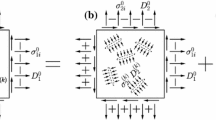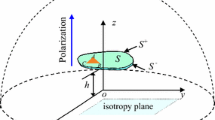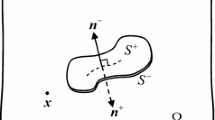Abstract
An assumption that the normal component of the electric displacement on crack faces is thought of as being zero is widely used in analyzing the fracture mechanics of piezoelectric materials. However, it is shown from the available experiments that the above assumption will lead to erroneous results. In this paper, the two-dimensional problem of a piezoelectric material with a crack is studied based on the exact electric boundary condition on the crack faces. Stroh formalism is used to obtain the closed-form solutions when the material is subjected to uniform loads at infinity. It is shown from these solutions that: (i) the stress intensity factor is the same as that of isotropic material, while the intensity factor of the electric displacement depends on both material properties and the mechanical loads, but not on the electric load. (ii) the energy release rate in a piezoelectric material is larger than that in a pure elastic-anisotropic material, i. e., it is always positive, and independent of the electric loads. (iii) the field solutions in a piezoelectric material are not related to the dielectric constant of air or vacuum inside the crack.
Similar content being viewed by others
References
Parton V Z. Fracture mechanics of piezoelectric materials [J].Acta Astronautic, 1976,3 (9): 671–683
Pak Y E. Crack extension force in a piezoelectric material [J].ASME J Appl Mech, 1990,57 (3): 647–653
Suo Z, Kuo C M, Barnett D M, Willis J R. Fracture mechanics for piezoelectric ceramics [J].J Mech Phys Solids, 1992,40 (4): 739–765
Sosa H A. On the fracture mechanics of piezoelectric solids [J].Int J Solids Structures, 1992,29 (21): 2613–2622
Pak Y E. Linear electro-elastic fracture mechanics of piezoelectric materials [J].Int J Fracture, 1992,54 (1): 79–100
Pak Y E, Tobin A. On electric field effects in fracture of piezoelectric materials [J]. AMD-Vol, 161/MD-Vol. 42,Mechanics of Electromagnetic Materials and Structure, ASME, 1993, 51–62
Sosa H A. Crack problems in piezoelectric ceramics [J]. AMD-Vol. 161/MD-Vol. 42,Mechanics of Electromagnetic Materials and Structure, ASME, 1993, 63–75
Dunn M L. The effect of crack face boundary conditions on the fracture mechanics of piezoelectric solids [J].Eng Fracture Mech, 1994,48 (1): 25–39
Park S B, Sun C T. Effect of electric field on fracture of piezoelectric ceramic [J].Int J Fracture, 1995,70 (3): 203–216
Beom H G, Atluri S N. Near-tip fields and intensity factors for interfacial cracks in disimilar anisotropic piezoelectric media [J].Int J Fracture, 199675 (2): 163–183
Zhang T Y, Tong P. Fracture mechanics for a mode III crack in a piezoelectric material [J].Int J Solids Structures, 1996,33 (3): 343–359
Kogan L, Hui C Y, Molkov V. Stress and induction field of a spheroidal inclusion or a penny-shaped crack in a transversely isotropic piezoelectric material [J].Int J solids Structures, 1996,33 (19): 2719–2737
Yu S W, Qin Q H. Damage analysis of thermopiezoelectric properties: Part I—Crack tip singularities [J].Theor Appl Fract Mech, 1996,25 (3): 263–277
Qin Q H, Yu S W. An arbitrarily-oriented plane crack terminating at the interface between dissimilar piezoelectric materials [J].Int J Solids Structures, 1997,34 (5): 581–590
Du Shanyi, Liang Jun, Han Jiecal. The coupled solution of a rigid line inclusion and a crack in anisotropic piezoelectric solids [J].Acta Mechanica Sinica, 1995,27 (5): 544–550 (in Chinese)
Yang Xiaoxiang, Kuang Zhenbang. The calculation of piezoelectric materials with a mixed mode crack [J],Acta Mechanicia Sinica, 1997,29 (3): 314–322 (in Chinese)
Sosa H A, Khutoryansky N. New developments concerning piezoelectric materials with defects [J].Int J Solids Structures, 1996,33 (23): 3399–3414
Chung M Y, Ting T C T. Piezoelectric solids with an elliptic inclusion or hole [J].Int J Solids Structures, 1996,33 (23): 3343–3361
Suo Z. Singularities. Interfaces and cracks in dissimilar anisotropic media [J].Proc R Soc Lond, 1990, A427: 331–358
Lothe J. Integral formalism for surface waves in piezoelectric crystals: Existence considerations [J].J Appl Phys, 1976,47 (5): 1799–1807
Muskhelishvili N I.Some Basic Problems of Mathematical Theory of Elasticity [M]. Leyden: Noordhoof, 1975
Wangsness R K.Electromagnetic Fields [M]. New York: John Wiley & Sons, 1979
Author information
Authors and Affiliations
Rights and permissions
About this article
Cite this article
Cunfa, G., Weixun, F. An exact solution of crack problems in piezoelectric materials. Appl Math Mech 20, 51–58 (1999). https://doi.org/10.1007/BF02459273
Received:
Issue Date:
DOI: https://doi.org/10.1007/BF02459273




